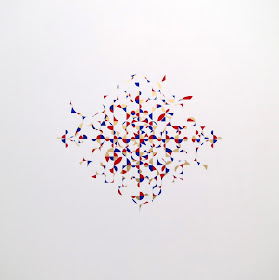'I stand, as it were, nude in front of the canvas, without intention, without plans, without a model, without photography, and let things take shape. But I have a starting point which arose from the realisation that the only truly real things are my own sensations, which transpire within the house of my body; they're physiological, the sensations of pressure when sitting and reclining, of tension and spatial extension - such things are rather difficult to depict'.
Maria Lassnig, A Painting Survey, at Hauser and Wirth, London.
Spanning work made from the 1950s to the end of the artist's life, this exhibition traces Maria Lassnig's evolution from early experiments with abstraction to a richly inventive figuration and the refinement of her 'body awareness' paintings in which she captured physical sensation as felt from within.

Lassnig spent most of the second half of the 20th century being overlooked. Dealers and curators couldn't see how to fit her work, which consisted of self-portraits, into any of the usual groupings. She was at different times both figurative and linear, realist and allusive, full and spare. The only thing that stayed the same was her subject matter, which was always herself.
Developing what she called 'body awareness painting' she depicted pain, thought, blood and breath, as if they were objects she could hold and scrutinise. 'The truth', she once explained, 'resides in the emotions produced within the physical shell'. She did not work from photography or observation but from what she called 'body awareness', a Surrealist-influenced method of painting only her mental perception of herself and her feelings. 'I do remember when it occurred to me the first time, when I got the idea of painting the way I feel at a given moment. I was sitting in a chair and felt it pressing against me. I still have the drawings where I depicted the sensation of sitting. The hardest thing is to really concentrate on the feeling while drawing. Not drawing a rear end because you know what it looks like, but drawing the rear end feeling'.
Beams, 1950, (oil on canvas)
Field-division black-white-grey 2, 1953, (oil on cardboard)
Field-division black-grey 8, 1953, (oil on cardboard)
Tachism 4, 1958, (oil on canvas)
Untitled, 1959, (oil on canvas)
Untitled, 1958-59, (oil on canvas)
Untitled, 1960, (oil on canvas)
Self-portrait as animal, 1963, (oil on canvas)
Two side by side, 1961, (oil on canvas)
Red-blue figuration, 1961, (oil on canvas)
Ring of thorns / woman in ring of thorns, 1963-64, (oil on canvas)
The earthly race, 1963, (oil on canvas)
Balancing myself, 1965, (oil on canvas)
Rabbit picture, 1962, (oil on canvas)
Self-portrait with wine glass, 1975, (oil on canvas)
Young woman with wine glass, 1971, (oil on canvas)
Language mesh, 1999, (oil on canvas)
Generation problems II, 1998-99, (oil on canvas)
Re-lations VI, 1994, (oil on canvas)
Lines of fate/re-lations VIII), 1994, (oil on canvas)
Scientists I and II, 1997, (oil on canvas)
Woman and Man, 2007, (oil on canvas)
Self-portrait with speech bubble, 2006, (oil on canvas)
Interruption, 1989, (oil on canvas)
Navel boat, 1991, (oil on canvas)
Large field-division/mirror, 1898, (oil on canvas)
TV child, 1987, (oil on canvas)
Gardener in the snow, 1986/87, (oil on canvas)




















































